|
Crayfish, Crawdads, Ditch Bugs
Identification
Related
Articles: Forget Crawfish
Pie, Let's Make a Crawfish Tank! By Gage Harford,
Invertebrates for Freshwater
Aquariums by Neale Monks, Freshwater Shrimp, Crayfish,
"Lobsters", Prawns Freshwater to Brackish
Crabs
Related FAQs: Crayfish 1,
Crayfish 2, Crayfish Behavior, Crayfish Compatibility, Crayfish Selection, Crayfish Systems, Crayfish Feeding, Crayfish Disease, Crayfish Reproduction, Freshwater Invertebrates/Use in
Aquariums, Freshwater Crustaceans for the Aquarium,
FW Crustaceans
2, Fresh to Brackish
Water Crabs, Hermit
Crabs,
|
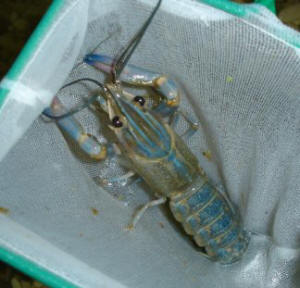
|
|
Orange Procambarus clarkii vs. CPO
4/6/16
Hi Bob,
How to identify whether an orange crayfish is a CPO dwarf or whether
it's the bigger clarkii one? The images online look very similar.
http://www.eliteinverts.com/cpo-dwarf-crayfish/
http://www.eliteinverts.com/bright-orange-crayfish/
Because I was expecting this to grow to only around 3 inches max and
it's in a 5 gallon tank. But I noticed it was already 2.5 inches plus.
So I'm wondering if it's a fully grown cpo or a very young clarkii? And
I'm not really sure about the scientific names as well. Sorry for any
mistakes! The pet store guy has no idea about it. And I'm not from the
US.
Thanks a lot!
- Matthews
<Let me refer you to the diagnosis of the genus Cambarellus,
here:
"First pleopod of first form male terminating in only 3 distinct parts;
the three terminals may be spiniform, somewhat truncate, spatulate or
even troughlike. In the male hooks are present on the ischipodites of
the second and third pereiopods. All species very small, not often
reaching a length of 50 mm." Grab yourself a dissecting lens, spin your
crayfish onto its back, and make the diagnosis as described. Cheers,
Neale.>
Re: Orange Procambarus clarkii vs. CPO
Thanks Neale!
<You're welcome! FWIW, the "Bright Orange Crayfish" is an artificially
bred form of Procambarus or similar. True Cambarellus, at least in the
UK, are rarely traded, and when they are, sold at small sizes and
premium prices.
Neale.>
|
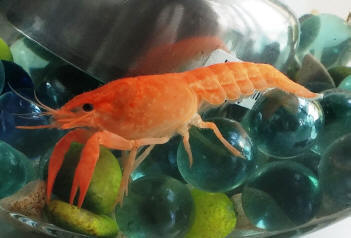 |
|
Procambarus clarkii? 4/26/13
Hi WWM crew, attached are pictures of my new little crayfish - any idea
what species he/she is?
<Mmm, no; there are many species... even just in the U.S.>
I thought perhaps Procambarus clarkii?
<Don't think so... I've kept this popular (to eat) species... it's more
"robust" and darker and more consistent in colour>
"He" is very small, about 5cm in length and orange in colour. Thanks for
your help! Catherine (South Africa)
<Ask around at the fishing/bait shops in your area re... It is likely
introduced (non-native)... They will most likely know.
Bob Fenner>
|
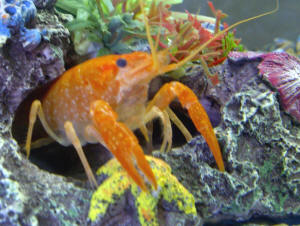
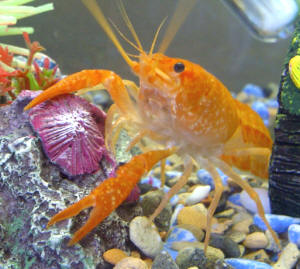 |
|
Can you tell me what kind of Crayfish I have?
6/21/11
Last week, on Thursday, my husband mentioned something about a
tower by the porch. He, points to the ground by the back porch.
There is a tower of Mud that stands about 10 in tall with a hole
in the middle. He said, I'm watching to see what comes out.
We figured a mole, or some kind of frog.
Friday we had a hard rain, and it washed away some of the tower,
so he is standing there watching to see what comes up. It started
coming to the top to rebuild the tower. When he saw what it was
he knock over the tower and put what came out in the fish tank
(it didn't have any fish anyway).
I know it is a Crawfish but not what kind. (I believe it is a
male). We live in Eastern Alabama middle of the state 10 miles
from the Chattahoochee River that separates GA and AL. We had a
creek that went through our back yard, it finally went
underground about 17 years ago. I have attached two pictures of
it.
About 7 years ago, we had been doing some digging in the back
yard and came upon some old rusty barrels, they were full of
water and it had a bunch of little ones in it, we caught 2 little
ones and one big one (not as big as this one). But they only
lived six months. I think the big one ate the little ones (along
with the rest of my fish). The big one also kept escaping the
tank.
With this one, we have removed all the fake plants and moved the
two fixtures that are left to the middle of the tank. And taped
over all the openings. It has a filter and heater, with gravel on
the bottom. I gave it a piece of cooked shrimp and put in flake
food. It has not eaten the shrimp. I would like to know what kind
it is and I have been reading your site for feeding tips.
Won't lettuce float? And should I just cut up small pieces of
carrots and zucchini? How much do you feed them?
Thanks for your help.
Michelle
<Hello Michelle. At first I thought this was Procambarus
pygmaeus on account of its small size and the orangey tips to the
pincers. But I do wonder if it is actually the common species
Procambarus clarkii. In any case, I'm fairly sure it's a
Procambarus species of some sort. As for care, do read here:
http://www.wetwebmedia.com/ca/volume_5/volume_5_3/crayfish_basics.htm
http://www.wetwebmedia.com/ca/volume_1/cav1i4/crayfish/crayfish.htm
Basic care is generally straightforward. Crayfish eat both plant
and animal foods and under aquarium conditions are very
omnivorous. Algae wafers, cooked peas, small bits of fish fillet,
unshelled shrimps all make good foods. Variety is important. Dose
the tank with iodine (sold for marine aquaria) at 50% the dose
stated on the bottle -- this is very cheap to do, and ensures
they moult properly. They tend to be aggressive as well as
predatory, so will harm one another as well as fish. They like to
dig, and yes, they will escape given the chance. Hope this helps,
Neale.>
|
|
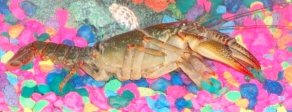 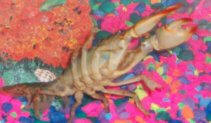
|
Re: Can you tell me what kind of Crayfish I have?
6/21/11
Thank you for letting me know what it is. I have read the basics
already and I've been reading everything else on your site. I
bought the Algae wafers and shrimp pellets for bottom feeders. I
only found 1 store with the iodine and it was such a large
bottle, I saw somewhere on your site that I should use, 1 drop
for a 10 gallon tank a week. Does that sound right?
<Hmm'¦ there's no rush here, so why not
mail-order a small bottle? Going without iodine won't hurt
for a few weeks; it's in the long term, once the animal uses
up the iodine it still has from its diet in the wild.>
Also, the girl at the store said I didn't need it, "we
don't use it here". I have seen your thoughts on things
like that.
<She may well not use iodine, and if she only keeps crayfish
in stock for a month or two each specimen, she doesn't have
to worry about the long-term health of these animals.>
I also have read some of the comments and thought I trust your
information more than hers. I will go back and get the big
bottle.
You mentioned its' small size, I thought it was pretty big.
When it is still and straight out from the tips of his claws to
the tip of his tail he is approximately 5 inches long. Does that
mean he will get bigger?
<Not by very much; this sounds like an adult P.
clarkii.>
I took the solid house out and replaced it with a new longer fake
log that had several openings in the sides and open at the bottom
so it could dig out and get comfortable.
<Cool.>
I have see several listings of foods for them but not sure how
much to feed, it also says to remove un-eaten food. But no
suggestions on volume or duration to leave it there. Any
suggestions for me? I don't want to under feed it or leave
extra for too long.
<Plant food can be left in indefinitely, so if you're away
for a couple weeks, just leave a bunch of Canadian Pondweed or
similar (as sold for ponds and Goldfish aquaria) and leave the
chap to graze at his leisure. But meaty food put out at night
should be removed if any remains in the morning. Feed sparingly.
One algae wafer (about the size of a penny) should be adequate
per night, 4-5 nights per week. Once a week supplement with
something meaty, perhaps single piece of fish or shrimp about the
size of your thumbnail. Leave live plants in as often as you want
for grazing. Also provide regular offerings (once or twice a
week) of something mostly calcareous for calcium. Squished pond
snails would be ideal, but otherwise try whole krill (from the
pet store), whole lancefish (again, from the pet store), or
unshelled mussels or prawns smashed with a rock or hammer. Again,
a thumbnail-sized portion is about right.>
Thanks,
Michelle
<Glad to help, Neale.>
Re: Can you tell me what kind of Crayfish I have?
Sys., nutr. 6/21/11
Thank you Neale! The information on what and how much to feed it
wonderful. The algae tables are not as big as a penny and the
seem to dissolve in about 5 minutes.
Did I get the wrong thing?
<Sounds like it. Use these for now; if the substrate is sandy
rather than gravel, the crayfish will "sift" the sand
and extract the nutrients.
Smooth, non-calcareous sand, like pool sand, is ideal for
crayfish tanks. The best algae wafers for crayfish are the sort
sold for Plecs, for example, Hikari Tropical Algae Wafers. These
take hours to fall apart. A German company called JBL also make a
whole range of foods expressly formulated for freshwater
crustaceans.
http://www.jbl.de/en/aquatics-freshwater-products/group/2780/crabs--shrimps
Although pricey, like most German products, they're
excellent. A pot used to supplement the foods outlined earlier
would be an excellent approach, and economical too.>
Thanks,
Michelle
Re: Can you tell me what kind of Crayfish I have?
6/21/11
Neale, it has gravel not sand.
<Acceptable, but less fun, and I'd argue less easy to keep
clean -- dirt sits on sand and can be pipetted out with a turkey
baster (a great tool for the aquarist!). Gravel has gaps that let
dirt sink down, so while it
*seems* cleaner, it's not.>
Where is the best place to get the sand?
<In the US, pool sand seems to be the easiest and cheapest
option. Here in England, I tend to buy something called smooth
silica sand (also called smooth silver sand as opposed to sharp
sand) that is widely sold in garden centres. In either case, the
stuff is very cheap.>
Do they have it at a pet shop?
<Some pet shops have non-calcareous sand (as opposed to the
coral sand used in marine tanks). But they usually charge several
times what garden centres charge.>
And I know I sound stupid but what is a "Pot" you
mentioned to supplement the diet?
<Pot, as in a container. I meant you could buy one container
of fancy-pants JBL food, and use it to supplement the kitchen and
frozen foods.>
Michelle
<Cheers, Neale.>
Re: Can you tell me what kind of Crayfish I have?
6/21/11
Thank you for the information. You were most helpful and patient
with me
for stupid questions. Have a great day.
Michelle
<Glad to help. Cheers, Neale.>
|
|
Crayfish Identification 3/19/11
Hi,
<Salve,>
I recently bought two crayfish from Petco that were labeled as
"Vanilla Lobster" and "Asian Blue Shrimp."
Both look exactly identical except the Vanilla Lobster is
completely white and the Asian Blue Shrimp is, well, blue (but
not a dark hue like that of and Electric Blue).
<These are rather odd. >
I live in WA and LFS label crayfish as lobsters and shrimp to get
around a law preventing the selling of crayfish as they are an
invasive species and people release their pets into the wild
regardless of how wrong it is.
<Indeed. In the UK, the only crayfish that is routinely and
legally sold as an aquarium pet is Cherax quadricarinatus, a
tropical species from Australia that cannot survive in UK waters.
Unfortunately, for you, there are other Cherax species from Asia
and New Guinea that share the same blue colouration, such as
Cherax sp. "Blue Moon" and Cherax destructor. On top of
that, some of the North American Procambarus species occur in
blue morphs as well, including Procambarus clarkii
"blue" and the standard form of Procambarus alleni.
Incidentally, Procambarus clarkii is also available in a white
morph, Procambarus clarkii "white". Some of the larger
fan shrimps can be mistaken for crayfish, most notably Atyopsis
gabonensis, but I don't think that's the issue here.
Similarly, big Macrobrachium species do turn up in the trade,
notoriously the giant species Macrobrachium rosenbergii, but
these are so distinct in terms of the length of their arms that
they're unlikely to be confused with crayfish, despite the
same blue colouration.>
I was wondering if you could please help me identify what species
of crayfish they are.
<Not really; but if Google some of the Latin names I've
given you, and visit the better crayfish sites like http://www.crusta10.de (you'll
need to be able to read German to make much headway there) and
compare my suggestions to what you have, you might be able to pin
things down yourself. Cherax species shouldn't be viewed as
"bad" in the sense of being pests in your part of the
US, because they're all warm-climate animals with minimal
tolerance for freezing conditions in winter. But further south in
the US they may be less welcome, and on the whole, the very
limited usefulness of crayfish doesn't (in my opinion) offset
their potential for causing harm. Since you CANNOT keep non-dwarf
crayfish safely alongside other fish -- they're ALL
opportunistic predators to some degree -- they're really of
interest only to those very few aquarists willing to set up a
crayfish-only system.>
I have enclosed pictures to hopefully help. The picture of the
Blue Crayfish is not a picture of my specimen (mine was avoiding
my camera at all costs) but of one that is identical.
Thank you for your time and effort.
Ryan
P.S. Sorry about the two pictures of my white crayfish being so
large. I don't know how to make them smaller.
<On the Macintosh at least, use the default image viewer,
Preview, choose "Adjust Size" from the Tools menu, and
then use the pull-down Fit Into'¦ option to choose a
useful size, say, 640 x 480. Then choose "Save
As'¦" from the File menu, and save the resized
photo where you want it. Easy as pie! I assume there's
something broadly similar on Windows. Cheers, Neale.>
|
|
 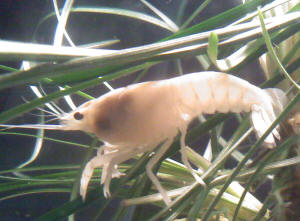
|
|
Can you identify, please? 3/15/11
Hi,
I have found lots if great info on your site, and was hoping you
can tell me what species my lobster/crawfish (not sure) is?
Thanks!
Elaine
<Looks like the Electric Blue "Lobster" to me,
Procambarus alleni. It is in fact a crayfish,
despite the name. Doesn't do well at tropical temperatures,
usually succumbing to a bacterial or fungal infection; keep
at room temperature instead. This species is primarily a
scavenger that consumes a good mix of plant foods alongside
carrion, but under aquarium conditions will attack fish and
shrimps during the night -- do not mix with fish or other
tankmates! Dose the tank with iodine as per marine aquarium
requirements, but at 50% the dose stated on the bottle. Without
iodine these crayfish often fail to moult reliably. Cheers,
Neale.>
|
|

|
|
Re: Can you identify, please? Crawdaddy, now incomp.
3/16/11
Thanks; I suspected he was an electric blue. I do add iodine,
started adding shortly after discovering your site, just after I
acquired the crayfish.
<Excellent.>
Just to let you know my experience with him - I got him when he
was just under 2" (he's molted once that I know of, its
been a few months that I have had him), & added him to my
community fish tank. I have a mix of guppies, platys, tetras,
Danios, & mollies; 'Krusty' and the fish seem to get
along well - the platys actually hang out in his cave with him,
and he doesn't seem to mind them visiting.
<Cool. But don't trust him completely! Any signs of
physical damage, especially to the slow-moving Guppies, and whip
him out. Yes, these animals are largely herbivorous in the wild,
but they will catch small fish given the chance.>
I do make sure I drop food at the entrance to or just inside his
cave, as the fish tend to not leave much for him otherwise. He
cruises the tank at night, sometimes in the morning as well,
provided I leave the light off.
<Indeed, they are very nocturnal.>
All that being said, I don't think I would recommend anyone
add one to their fish tank, unless its a large enough space with
sufficient shelter and cover (I have lots of live & plastic
plants, so even when not in his cave my crayfish has plenty of
hiding places).
<Are indeed fascinating pets, but on the whole, best kept in
their own tank. Cheers, Neale.>
|
Dear Crew,
What species of fish is this and how do you care for it?
8/5/10
[image: Blue Cray's Avatar]
<http://www.fishforums.com/forum/members/blue-cray.html>
Thank you, Dante G.
<No idea. We're not members of that forum so can't see the
pictures. For what it's worth, the Electric Blue Crayfish is
Procambarus alleni, an Australian species that's easy to keep in --
it's own!!! -- tropical aquarium. Cheers, Neale.>
Keeping Freshwater Crayfish (Yabbies, Koonac, Crawdad) Using WWM
1/23/07 I live in Australia, in Australia we call freshwater
crayfish "Yabbies" or "Koonac". In America I think
they call them "Crawdads", I wanted to find out some info on
keeping them. Thanks Dylan <Mmm, yes... See WetWebMedia.com re...
the indices, search tool... with these terms... We have articles, FAQs
files re these crayfishes. Bob Fenner>
Differences between lobsters/crayfish/species....?
1/26/06 I recently purchased an "electric blue lobster"
from a trusted pet store, but when I search the internet for
information, I find many different names/species/varieties. <Yes...
you start to understand the value in scientific names... many organisms
have more than one common moniker, and these are often applied to more
than one species> I called the pet store to see if they knew the
Latin name of the species they sold me, but to no avail. I have
searched for hours for a way of determining what it is that I have
actually purchased. Could you enlighten me as to what the physical
differences are between lobsters versus crayfish, species of crayfish,
and how to identify what variation I have? <Can... a beginning...
both common names are applied to a few groups of crustaceans... marine
and fresh... that is, the terms crayfish and lobster are often used for
different taxonomic groups... They are not definitive as to their
systematic classification> I also wanted to commend you on the
fantastic website you have here. I am extremely impressed (almost a
little overwhelmed) by the enormous amount of information you supply.
Thank you!! Tammy <A photograph will be useful here. Have you read
through the freshwater and marine articles on crayfish and lobsters
posted on WWM? There are some pix, systematic information,
identifications there. Bob Fenner>
| FW Crayfish in N. America ID - 1/30/2006 What Would
These Interesting Specimen Be Classified As. I Fish Them Out Of The
Delaware River. <Are some sort of crayfish... aka crawdad... Use
your search tools to find more by putting this word and
"Delaware River". Bob Fenner> |
|
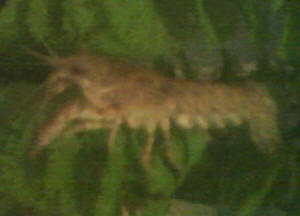
|
Shrimp/Crayfish As a Valentine's Day gift for
my two sons, my husband purchased two African Clawed Frogs, while the
man at the pet store was trying to catch the albino frog, he came
across a little guy my oldest son likes to call "Pincher." He
gave him to us for free since he wasn't sure what he was. I think
he's either a shrimp or crayfish of some kind. How do you tell the
difference between the two? He's about 1 inch long with two
pinchers and a grayish/brown color and a flat fan like tail. I would
greatly appreciate your answer. Thank you. Susan <Hi Susan,
generally crayfish are larger than shrimp. It's hard to say without
a picture. Does it look like any of these: http://www.thekrib.com/Fish/Shrimp/
Regards, Gage>
Shrimp/Crayfish I am going to try and get a
picture sent to you of "Pincher". <Awesome> I looked at
the site you sent and couldn't find any one shrimp that looked
enough like him, they all resembled him but not enough for me to say
he's a shrimp. The only other way I can describe him is he likes to
hoard food, he at first didn't mind the African Clawed Frogs but
then suddenly started to chase them around and even pinched off some of
the little albino frogs toes. <Maybe a crayfish, they are pretty
aggressive.> He has dug himself a little home in the gravel under a
decoration in the tank. I know this probably doesn't help you much
more, so like I said I'm going to try to get a picture sent to you.
Thanks for all your help. <In my experience freshwater shrimp will
usually do their best to hide and avoid confrontation with anything and
everything. This sounds like a crayfish to me, I named mine "fish
pinchin' crawdad" I'm working on a country song about him.
A picture would be great. Regards, Gage> Susan
Blue Water Lobster Dear Bob <Hey there - I'm not Bob,
but I am the freshwater invert-obsessed Sabrina - hope I can shed some
light on your new critter.> We have a Blue fresh water Lobster but
are having a few tiny problems with him/her and wonder if you may have
any answers? <Hmm.... I've seen a few different animals that
fall under this name, any of which might be the critter you've got.
It could be any of a handful of Procambarus species (crayfish) that is
blue or has a blue form; or could be either of two blue Macrobrachium
shrimp species - M. rosenbergii from Thailand or another species from
Mexico. A picture would go a long way to identifying it, if you've
got one.> He is attacking the big Plec and ripping the Pleco's
fins. He has also started recently to kill the smaller fish by grabbing
them with his claws. <For any of the species above, this is quite
normal.... they don't play well with fish.> Is there any way we
can stop this? <No, not really. Separating him from the fish is
pretty much the only way to end the carnage.> We have now put in a
ceramic pot and cave entrance to give him a safe cover, will this help
combat the problem? <No, unfortunately. Regardless of which of the
above critters it is - they're aggressive, and fish-hungry.> We
feed him on prawns <Excellent food for 'em> and specially
bought crab cuisine which states is ok for Lobsters. Should we be
feeding him anything else? <Ocean Nutrition's frozen Formula One
is a good food choice.> We have looked everywhere for a book on
Lobsters but have had no luck. <Do some Google searches on 'blue
crayfish' and 'blue prawn', as well as the above Latin
names.> He is now about 4 inches long without counting the claws.
<And will grow about twice that> He is shedding about every three
to four months and eats his shell afterwards. We have had him now for
ten months and has shed three times. He is showing signs of being due
for another shed as he is constantly laying on his side and acting as
though he is dead, which we have noticed he does this just prior to
shedding in the past. <I don't think that's a good sign....
perhaps try adding iodine to the tank (use Kent's marine Iodine
supplement); one drop per ten gallons every week.> He is constantly
shoveling the stones about, we have had to change from a sand bottom as
he kept blocking the filter with the constant moving of the sand. We
now have an undergravel filter. If you have any information that will
help our Lobster Rocky to have a good life, would you please be so kind
and inform us? <I am sorry for the news that he'll be always
incompatible with most fish; he may warrant a tank of his own. There
are a few fish compatible with these animals; do some Google searches
to try to find out exactly what you've got, and hopefully
that'll help you out some. Wishing you well, -Sabrina> Thank you
in anticipation. Yours sincerely Mr. John Edwards
|
|

